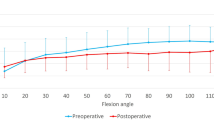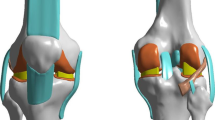Abstract
The approach to the posterior cruciate deficient knee is controversial. The purpose of this study is to document the biomechanical changes in the static cadaveric knee model with simulated physiological loads. Nine fresh cadaveric knees from young donors (aged under 45 years) were mounted on a materials testing machine. Loading was carried out at 0°, 30° and 60° to 1.5 kN with low-pressure sensitive Prescale film (Fuji; Tokyo, Japan) inserted through arthrotomies into the medial and lateral compartments. Computerized analysis of the imprints on the film was then carried out. Tests were then repeated after cutting the posterior cruciate ligament (PCL). Results demonstrate a statistically significant posterior subluxation of the tibia on the femur at 60° flexion. This causes a significant increase in contact pressure and pressure concentration on the medial compartment of the knee after cutting the PCL. This may help explain the long-term degenerative changes observed in the medial femoral condyle after cutting the PCL.
Similar content being viewed by others
References
Cain TE, Schwab GH (1981) Performance of an athlete with straight posterior knee instability. Am J Sports Med 9:203
Clancy WG, Shelbourne KD, Zoellner GB, Keene JS, Reider B, Rosenberg TD (1983) Treatment of knee joint instability secondary to rupture of the posterior cruciate ligament. J Bone Joint Surg [Am] 65:310
Cross MJ, Owell J (1981) Natural history of posterior cruciate ligament disruption. Orthop Trans 5:486
Dandy DJ, Pusey RJ (1982) The long term results of unrepaired tears of the posterior cruciate ligament. J Bone Joint Surg [Br] 64:92–94
Degenhardt TC, Hughston JC (1981) Chronic posterior cruciate instability: non-operative management. Orthop Trans 5:486–487
Fowler PJ, Messieh SS (1987) Isolated posterior cruciate injuries in athletes. Am J Sports Med 15:553
Fu F, Thompson WO, Thaete FL (1991) Meniscal pathomechanics by 3D magnetic resonance imaging. Presented at the International Arthroscopy Association Meeting, Toronto, Canada
Fukubayashi T, Kurosawa H (1980) The contact area and pressure distribution pattern of the knee: a study of normal and osteoarthritic knee joints. Acta Orthop Scand 51:871–879
Hughston JC, Bowden JA, Andrews JR, Norwood LA (1980) Acute tears of the posterior cruciate ligament. J Bone Joint Surg [Am] 62:438
Inaba H, Arai M (1989) A method for measuring contact pressures instantaneously in articular joints. J Biomech 22:1293
Kennedy JC, Grainger RW (1967) The posterior cruciate ligament. J Trauma 7:367
Loos WC, Fox JM, Blazina ME, Del Pizzo W, Friedman MJ (1981) Acute posterior cruciate ligament injuries. Am J Sports Med 9:86
Minlaci A, Patek R, Shields CL, Tibone JE, Perry J, Pink M. A functional analysis of the posterior cruciate deficient knee. (unpublished data)
McMaster WC. Isolated posterior cruciate ligament injury: literature review and case reports. J Trauma 15:1025–1029
Ogata K, McCarthy JA, Dunlop J, Manske PR (1988) Pathomechanics of posterior sag of the tibia in posterior cruciate deficient knees. An experimental study. Am J Sports Med 16:630
Paradis PD (1990) A design analysis of a total knee implant using Fuji pressure sensitive film. Thesis, University of Western Ontario
Singerman R, Pederson D, Brown T (1988) Quantitation of Fuji Prescale pressures using digital image scanning. Thesis, University of Iowa
Skyhar MJ, Warren RF, Ortiz GJ, Schwartz E, Otis JC (1993) The effects of sectioning of the posterior cruciate ligament and the posterolateral complex on the articular contact pressures within the knee. J Bone Joint Surg [Am] 75:694–699
Tibone JE, Antich TJ, Perry J, Moynes D (1988) Functional analysis of untreated and reconstructive posterior cruciate ligament injuries. Am J Sports Med 16:217
Torg JS, Baron TM, Pavlov H, Stine R (1989) Natural history of the posterior cruciate ligament deficient knee. Clin Orthop 246:208
Werner F, Murphy D, Palmer A (1989) Pressures in the distal radioulnar joint: effect of surgical procedures used for Kienbock's disease. J Orthop Res 4:445
Author information
Authors and Affiliations
Rights and permissions
About this article
Cite this article
MacDonald, P., Miniaci, A., Fowler, P. et al. A biomechanical analysis of joint contact forces in the posterior cruciate deficient knee. Knee Surg, Sports traumatol, Arthroscopy 3, 252–255 (1996). https://doi.org/10.1007/BF01466628
Received:
Accepted:
Published:
Issue Date:
DOI: https://doi.org/10.1007/BF01466628




